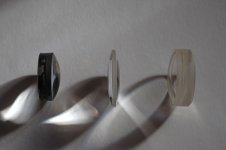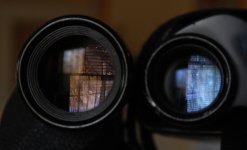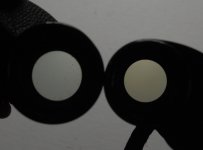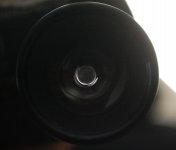henry link
Well-known member
Thanks to John Dracon, I’ve had the opportunity to play around with a monocular version of the Fuji made Rangemaster for the past couple of weeks. Reading back over this thread I see that much has already been well covered, so I’ll try not to repeat what’s already been said, except to confirm a few things. I’m afraid most of what I have to add falls into the realm of minutiae, probably only of interest to fans and collectors of this model. As always, my findings apply only to this particular specimen. It’s possible that some design details changed along the way.
First off, I didn’t find anything out of the ordinary about the design. The objective is a cemented doublet of about f/4 or a little less. I disassembled the ocular and found it to be a conventional 5 element Erfle of around 20mm focal length (see the photo below of the lens set.) One nicety is the edge blackening of the eye lens doublet visible in the photo. Overall, this is a simple, tried and true design from the 1920’s, updated only by the use of anti-reflection coatings (the optics are “fully coated” even though the prism cover reads “coated optics”).
The coating itself turned out to be very interesting to me. Most single layer coating shows blue/purple reflections, but this Rangemaster’s coating falls generally into the class of “amber” single layer coatings. I’ve seen something similar in Swift, Leitz, and Fujinon binoculars of the same period and a coating of similar appearance is still used even today by Vernonscope for Brandon telescope eyepieces.
I haven’t had much luck finding information about “amber” coating. The thread from Cloudy Nights below offers some speculation.
http://www.cloudynights.com/ubbthreads/showflat.php/Cat/0/Number/5714482/Main/5708023
I’m inclined to give some credence to Gordon Rayner’s idea that coating thickness is involved, but it’s also possible that the coating material is something other than magnesium fluoride. Anybody else have some information about this?
It appears to me that “amber” coating is somehow tuned for the transmission to peak at a shorter wavelength than “purple” coating and it also may have a somewhat more linear bandwidth. At any rate, what I notice about the amber coated binoculars I’ve seen is that the color bias appears to be cooler and more neutral to my eye than the usual yellow biased color transmission of MgF coated binoculars with blue/purple reflections. The left center photo below shows the Rangemaster reflection colors compared to a Nikon 8x30 E and the right center photo shows the color change in white paper after transiting the optics of the two. To my eye the Rangemaster is much more neutral and actually a pretty close match to the bias of my Zeiss 8x56 FL; that is a little cool and slightly greenish. I wonder why the amber variant of single layer coating, which looks superior to me, wasn’t used more often in the days before multi-coating.
I measured resolution using the 1951 USAF pattern and did the usual star-test (both at 57x). Resolution was around 3.55”, which is excellent and about the same as the 7x35 Nikon Action I I tested a few years ago. There’s no real surprise there, since the star-test showed no defects that would seriously reduce resolution. There are only the typical chromatic and spherical aberrations that are to be expected from a fast cemented doublet. They’re largely innocuous at 7x, especially when they‘re effectively reduced in bright light by the aperture stop imposed by the eye.
The off-axis aberrations of the Erfle eyepiece are also about as expected. I measured about 6D of astigmatism and 3D of field curvature near the field edge. On the other hand the sweet spot (loss of no more than 1 element on the USAF chart) is acceptably large at around 25-26º of apparent field, similar to my 8x56 FL, which for me is just good enough to cause no complaints, though it’s far from the best that can be done by binoculars with field flatteners.
I found that considerable pincushion distortion develops toward the field edge. It’s a bit more than is strictly required to correct angular magnification distortion, so there is slight negative AMD at the edge of the field (circular objects appear radially stretched rather than compressed). The extra pincushion has the “benefit” of boosting the AFOV above other binoculars, which have the same AFOV as the Rangemaster when mathematically calculated. For instance, the 10x35 Nikon EII with a 7º field should have the same AFOV as the Rangemaster 7x35 with a 10º field, but in fact the Rangemaster AFOV is several degrees wider than the EII, owing to the extra distortion.
I measured the true clear aperture at 34mm. Oddly enough the objective lens measured from the front (with the trim ring removed) measures 37mm. When the trim ring is in place it overlaps the objective glass edge and reduces the clear aperture to 35mm. The final reduction to 34mm comes from a slightly undersized prism shelf aperture. The prisms themselves are actually quite large (27mm on the minor axis), just not quite large enough to avoid causing a slight aperture reduction in such a wide field optical system.
There is a series of reflections at the edge of the exit pupil which compromises glare resistance. The first one is “external” and comes from the inside of the trim ring. The next one comes from the objective lens cell and the third one from the prism shelf aperture. The prism shelf reflection is the only one that does any real damage, because its undersized aperture blocks the other two from reaching the eye when the eye pupil is well centered (see exit pupil photo). Looking into the binocular from the front you can see a reassuring looking ribbed baffling cone, which, as unfortunately is often the case, is largely ineffective because the front of it is too large to block the trim ring/objective cell reflections and its back aperture is too large to shield the prism shelf aperture. I don’t want to exaggerate the veiling glare “problem” the Rangemaster exhibits. It’s easy enough to see in the very difficult test set-up I use, but in the field it’s only likely to show up under very unfavorable back light conditions and, even then, it’s far from the worst I’ve seen.
Finally, I measured the eye relief at 14mm from the glass, which others have mentioned as the official spec. With the hard eyecup in place the eye relief is perfectly comfortable for me without eyeglasses.
I can easily understand the enthusiasm this model has generated. It’s built very much like WWII military binoculars, which is to say very very well. Even the monocular version is impressively immersive and comfortable to look through. However, there is no secret sauce that I can find in the optical design. I think this is just what you get from a simple, old-fashioned Porro with a cemented doublet objective and an Erfle eyepiece, when that venerable 90 year old design is well executed.
I haven’t returned the monocular to John yet, so if there is anything else anybody wants me to check out while I have it, please let me know.
Henry Link
First off, I didn’t find anything out of the ordinary about the design. The objective is a cemented doublet of about f/4 or a little less. I disassembled the ocular and found it to be a conventional 5 element Erfle of around 20mm focal length (see the photo below of the lens set.) One nicety is the edge blackening of the eye lens doublet visible in the photo. Overall, this is a simple, tried and true design from the 1920’s, updated only by the use of anti-reflection coatings (the optics are “fully coated” even though the prism cover reads “coated optics”).
The coating itself turned out to be very interesting to me. Most single layer coating shows blue/purple reflections, but this Rangemaster’s coating falls generally into the class of “amber” single layer coatings. I’ve seen something similar in Swift, Leitz, and Fujinon binoculars of the same period and a coating of similar appearance is still used even today by Vernonscope for Brandon telescope eyepieces.
I haven’t had much luck finding information about “amber” coating. The thread from Cloudy Nights below offers some speculation.
http://www.cloudynights.com/ubbthreads/showflat.php/Cat/0/Number/5714482/Main/5708023
I’m inclined to give some credence to Gordon Rayner’s idea that coating thickness is involved, but it’s also possible that the coating material is something other than magnesium fluoride. Anybody else have some information about this?
It appears to me that “amber” coating is somehow tuned for the transmission to peak at a shorter wavelength than “purple” coating and it also may have a somewhat more linear bandwidth. At any rate, what I notice about the amber coated binoculars I’ve seen is that the color bias appears to be cooler and more neutral to my eye than the usual yellow biased color transmission of MgF coated binoculars with blue/purple reflections. The left center photo below shows the Rangemaster reflection colors compared to a Nikon 8x30 E and the right center photo shows the color change in white paper after transiting the optics of the two. To my eye the Rangemaster is much more neutral and actually a pretty close match to the bias of my Zeiss 8x56 FL; that is a little cool and slightly greenish. I wonder why the amber variant of single layer coating, which looks superior to me, wasn’t used more often in the days before multi-coating.
I measured resolution using the 1951 USAF pattern and did the usual star-test (both at 57x). Resolution was around 3.55”, which is excellent and about the same as the 7x35 Nikon Action I I tested a few years ago. There’s no real surprise there, since the star-test showed no defects that would seriously reduce resolution. There are only the typical chromatic and spherical aberrations that are to be expected from a fast cemented doublet. They’re largely innocuous at 7x, especially when they‘re effectively reduced in bright light by the aperture stop imposed by the eye.
The off-axis aberrations of the Erfle eyepiece are also about as expected. I measured about 6D of astigmatism and 3D of field curvature near the field edge. On the other hand the sweet spot (loss of no more than 1 element on the USAF chart) is acceptably large at around 25-26º of apparent field, similar to my 8x56 FL, which for me is just good enough to cause no complaints, though it’s far from the best that can be done by binoculars with field flatteners.
I found that considerable pincushion distortion develops toward the field edge. It’s a bit more than is strictly required to correct angular magnification distortion, so there is slight negative AMD at the edge of the field (circular objects appear radially stretched rather than compressed). The extra pincushion has the “benefit” of boosting the AFOV above other binoculars, which have the same AFOV as the Rangemaster when mathematically calculated. For instance, the 10x35 Nikon EII with a 7º field should have the same AFOV as the Rangemaster 7x35 with a 10º field, but in fact the Rangemaster AFOV is several degrees wider than the EII, owing to the extra distortion.
I measured the true clear aperture at 34mm. Oddly enough the objective lens measured from the front (with the trim ring removed) measures 37mm. When the trim ring is in place it overlaps the objective glass edge and reduces the clear aperture to 35mm. The final reduction to 34mm comes from a slightly undersized prism shelf aperture. The prisms themselves are actually quite large (27mm on the minor axis), just not quite large enough to avoid causing a slight aperture reduction in such a wide field optical system.
There is a series of reflections at the edge of the exit pupil which compromises glare resistance. The first one is “external” and comes from the inside of the trim ring. The next one comes from the objective lens cell and the third one from the prism shelf aperture. The prism shelf reflection is the only one that does any real damage, because its undersized aperture blocks the other two from reaching the eye when the eye pupil is well centered (see exit pupil photo). Looking into the binocular from the front you can see a reassuring looking ribbed baffling cone, which, as unfortunately is often the case, is largely ineffective because the front of it is too large to block the trim ring/objective cell reflections and its back aperture is too large to shield the prism shelf aperture. I don’t want to exaggerate the veiling glare “problem” the Rangemaster exhibits. It’s easy enough to see in the very difficult test set-up I use, but in the field it’s only likely to show up under very unfavorable back light conditions and, even then, it’s far from the worst I’ve seen.
Finally, I measured the eye relief at 14mm from the glass, which others have mentioned as the official spec. With the hard eyecup in place the eye relief is perfectly comfortable for me without eyeglasses.
I can easily understand the enthusiasm this model has generated. It’s built very much like WWII military binoculars, which is to say very very well. Even the monocular version is impressively immersive and comfortable to look through. However, there is no secret sauce that I can find in the optical design. I think this is just what you get from a simple, old-fashioned Porro with a cemented doublet objective and an Erfle eyepiece, when that venerable 90 year old design is well executed.
I haven’t returned the monocular to John yet, so if there is anything else anybody wants me to check out while I have it, please let me know.
Henry Link
Attachments
Last edited:








